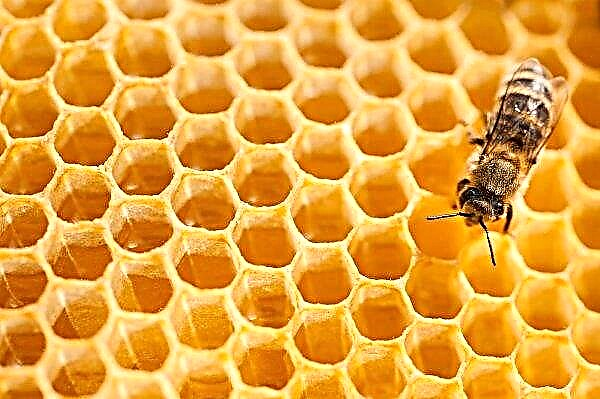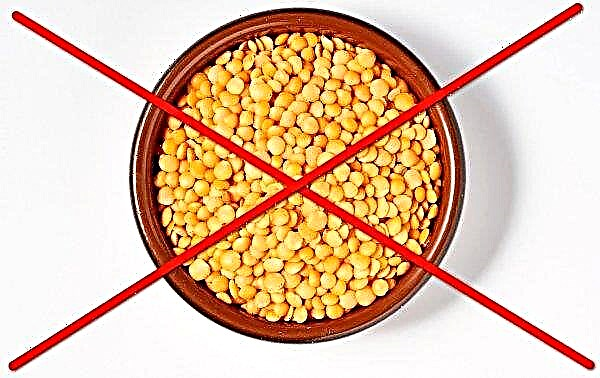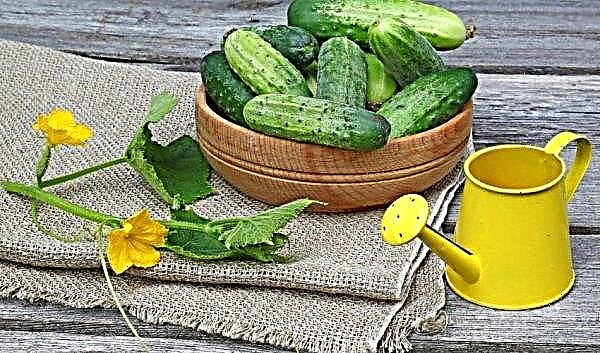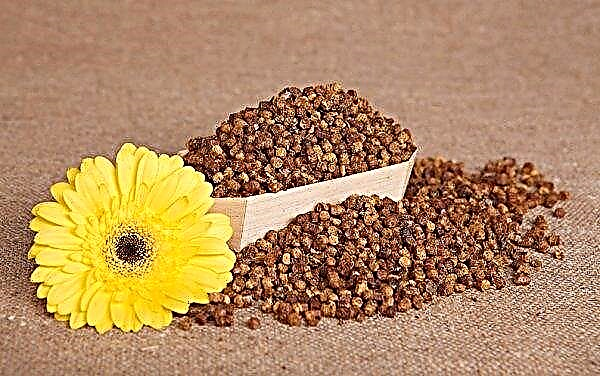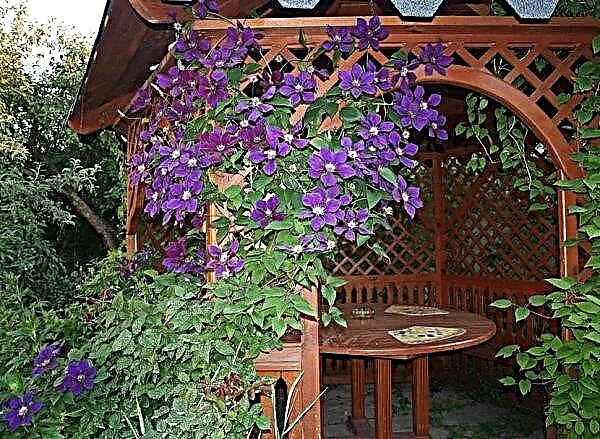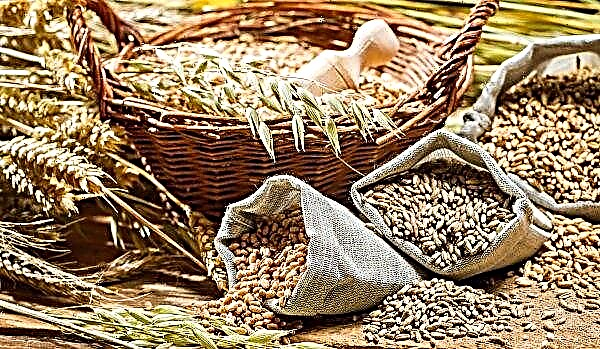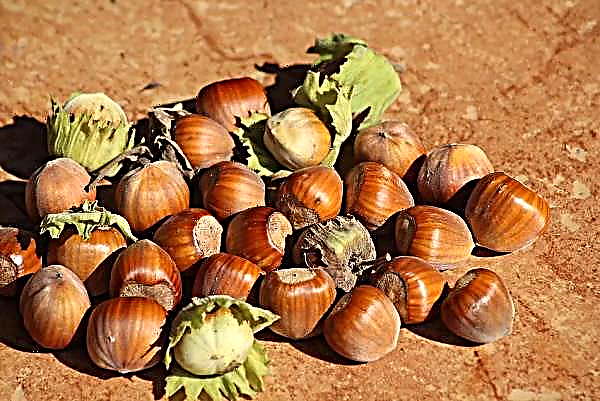The plant, known today as indoor violet, was discovered by Baron Walter von Saint-Paul in the 19th century in the mountains of Tanzania. It was from the moist forests of Africa that the flower came to Europe, where since then more than 300 varieties of it have been created, including the variety “Raisins”. How it differs from other violets and whether it has its own characteristics of growing, we will consider in the article.
Botanical description of the plant
Violet "Raisins" is a perennial herb from the Gesneriev family.
Its appearance can be described as follows:
- the flower bush looks like a rosette from which leaves puff in all directions on red-brown shoots;
- the leaf plates themselves are slightly elongated, have the shape of an oval;
- the leaves are fleshy and have different shades - saturated green on the outside and light emerald - on the inside;
- below the leaves near you can see thin reddish veins;
- the roots of "Raisins" are compact and underdeveloped, refer to the fibrous type.
This violet blooms in spring, from March to May. At this time, outlets appear on the brushes of 6-9 flowers. Their colors are blue-violet with snow-white or pinkish stains. Petals are decorated with wavy edges with a light border. Sometimes you can find specimens in which white and blue areas are separated with a pale raspberry hue. The middle of the flower is snow-white, and the diameter of the entire flower bowl can reach 5–6 cm.
In the summer, in place of flowers on the rosettes, boxes with seeds are formed, which finally ripen in August.Did you know? The ancient Romans revered violet, calling it the flower of Jupiter.
Video: review of raisins
What conditions do you need to create at home
All flower growers love violets for their versatility: all varieties of this plant have the same requirements for comfort and healthy growth.
Placement and lighting
"Raisins" need diffused, but bright light at least 11-14 hours a day. The best option for the location of this flower is the east or west window, where direct sunlight is not so scorching. Violet "Raisins" can grow on the south side, but at lunchtime in the summer it will need partial shade.
In winter, the lack of natural light for the plant is compensated by fluorescent lamps, which are turned off once an hour for 10 minutes. If you placed the raisin "Raisins" on the windowsill, then in the cold season it is better to put them on a pallet or transfer them to a table near the window so that the roots do not freeze.
When choosing a place for a flower, remember that he does not like drafts.
Important! If you want to get a symmetrical bush of violets, periodically turn the flowerpot around axisso that the light evenly hits the plant.
Temperature and humidity
Normal room temperature is most often suitable for raisins. In summer, the best option would be + 20 ... 25 ° C (for young actively growing specimens, you need at least + 26 ... 28 ° C), and in winter the room should not be colder + 18 ° C.
It is also important to remember the daily temperature fluctuations, which also matters for the flower. Differences of 2-3 degrees are permissible between the day and night levels, but not more. It is better to protect the violet from a sharp jump in temperature, otherwise you can damage the leaves or even disrupt flowering.
Raisins do not grow well without proper moisture. The ideal indicator for him is 50%. To maintain this level, use a spray bottle. However, do not spray moisture onto the plant, but moisten the air above it, otherwise drops on the leaves will provoke the development of the fungus on it.
It is also possible to use pallets with wet stones, but you do not need to immerse the flowerpot in water.
How to care at home
Even a novice flower grower can take care of the raisins "Raisins" - you just need to familiarize yourself with the care recommendations and regularly follow them.
Watering
Violets need moisture, but its excess affects them negatively, so watering should be moderate and only with the use of standing water. A positive effect on the plant and rain, melt water. You can use a liquid at room temperature or even slightly warm it if necessary.
Important! It is recommended to water the violet once a week in the winter and at least twice in the summer. Do not prime too much, but also do not allow long drying out. Half an hour after watering, drain the liquid from the pan to prevent its stagnation.
Since the flower does not like watering under the root, it is better to use alternative methods:
- moisten the soil through the pallet;
- apply drip irrigation;
- water by immersing the pot in water.
If you use the latter method, be sure to let the liquid drain well afterwards and thoroughly wipe the moisture from the flowerpot.

Top dressing
For the regular flowering of Violet Raisins, you can’t do without fertilizing and fertilizing: you need to make them during the period of active growth from March to August.
It is most effective to apply liquid mineral complexes and introduce them into moist soil: this is how beneficial substances are better absorbed. Among the purchased preparations, Rainbow, Ideal, etc. are suitable for the plant. It is necessary to use fertilizer according to the instructions for each remedy.
As soon as the flowering period ends, you can stop feeding.
Did you know? Decoctions of violets are used to treat cough and bronchitis.
Pruning
Violets are not pruned - they just remove broken cuttings, damaged, withered leaves, so that the plant does not waste strength and resources on them.
Transfer
The “Raisin” transplant is carried out in the spring, because in other seasons there are no suitable conditions for rooting the plant in a new pot: it is too hot in summer, it is cold in winter, and the flower is weakened in autumn after flowering.
The procedure is carried out in a number of cases:
- when the flower becomes cramped in the pot. The diameter of the violet bush should be 3 times the size of the flowerpot. If he outgrows this proportion, then it's time to transplant;
- immediately after buying the plant;
- if white plaque appears on the soil in the pot (may be a sign of fungus);
- when the soil is exhausted (yellowing leaves, lethargy of the plant testify to this);
- after rooting the cuttings.

An important role for the healthy development of violets is the size of the pot. It is best to take plastic products for this flower, and select the volume according to the diameter of the bush.
Important! Violet "Raisins" will not begin to bloom until the root system completely braids the pot from the inside.
Having chosen the necessary capacity, proceed to its filling. First of all, you need to provide drainage with a thickness of at least 3 cm. Then lay the soil: special purchased substrates for violets are suitable, or you can collect the appropriate composition yourself. To do this, you need non-acidic garden soil (previously it should be heated in the oven at temperatures above 100 ° C to disinfect), peat and sand in equal proportions.
The transplant process itself is as follows:
- Old and damaged leaves are removed from the plant.
- If wounds remain, they should be treated with charcoal.
- The pot is laid out with expanded clay and is almost completely filled with prepared soil.
- After the plant is lowered into a new container, trying not to damage the root system.
- The leaves of the bush should slightly touch the soil, so if necessary, you can add earth to the pot.

It is not necessary to water the transplanted raisins "Raisins" immediately, but it is worth covering the bush with a film for 2-3 days.
Timely transplantation will help provide a decorative look to the plant, its flowers will not fade, the roots in the new soil will rejuvenate, and the risk of root rot disease will be significantly reduced.
How to propagate at home
Propagate the raisin violet in several ways:
- cuttings;
- dividing the bush;
- seeds.

Do this as follows:
- The leg of the selected handle is cut obliquely, separating it from the mother bush.
- For 2-3 seconds, the place of the cut is immersed in a weak solution of potassium permanganate, and then left to dry for half an hour on pure material.
- Next, you need a small plastic container with drainage holes and a moist substrate, where the stalk is planted.
- Watering is not necessary, it is better to cover the seedling immediately with a film or a paper box and leave it in this form until the roots appear. Periodically, it is worth opening the flower so that mold does not appear on the ground.
- After the appearance of the roots, the plant needs to be transplanted into a full-fledged small pot.
Sometimes a plant is transplanted by dividing the root outlet. This method requires certain skills, moreover, it is so easy to damage the flower. The roots are separated during the next transplant, if the plant has a large outlet: it is extremely undesirable to cut. The resulting dividend is immediately planted in a separate pot.Did you know? Violet-based ointments are used to treat skin diseases.

Growing from seeds is suitable for lovers of home plants who enjoy working with flowers, because it is a long and painstaking process. At the same time, you can use both purchased and personally harvested seed.
The whole process of growing violets "Raisins" from seeds is as follows:
- In a small container, it is necessary to compact a thin (up to 2-3 cm) layer of substrate.
- Moisten the soil, make holes in it.
- Seeds are combined with sand in equal parts, and then poured into the recesses.
- It is not necessary to sprinkle them with earth, as they need light.
- Cover the container with seeds with a transparent lid and send to the light. Sprouts are best germinated at a temperature of + 22 ... + 25 ° C.
Important! Growing a violet from seeds collected personally, be prepared for the fact that the color of the flowers on the new plant will be different from the mother. This happens due to the mixing of seed of different copies of violets.
- Once every 2-3 days, moisten the soil well with a spray gun.
- On average, after 20-25 days, the first shoots appear.
- When they reach a height of 0.5 cm and the first leaves hatch at them, it will be necessary to pick the seedlings so that the distance between them is at least 2-3 cm. If you need to remove the sprout from the ground, take a toothpick and carefully “dig” her sprout.
- The second pick is carried out when the seedlings grow up and they again become closely in the tank. They are transplanted into separate containers - plastic cups are perfect for these purposes.
- When the plants are firmly rooted, they can be planted in full pots.
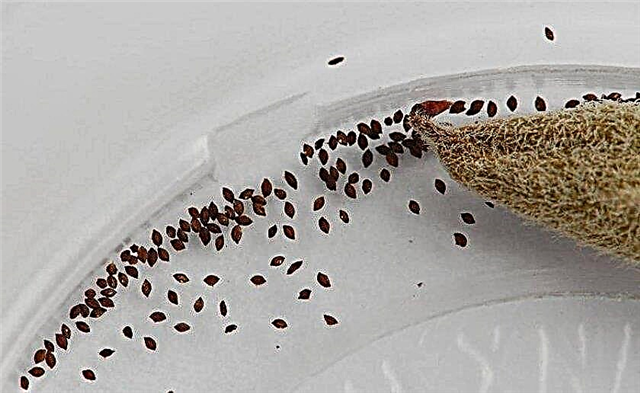
Possible growing difficulties
Often when growing violets at home, you can encounter a number of problems. The most common among them is a complaint that Raisins do not bloom.
There are many reasons for this, so you need to pay attention to additional signals:
- if also young leaves on the flower stretch upwards, then the violet has little light;
- sometimes the leaves lose their elasticity, which indicates a lack of water;
- if the buds appear, but quickly fade, not having time to bloom, then the air in the room is too dry;
- when there are no concomitant signs, the violet lacks useful substances, and feeding should be carried out more often.
Learn about a violet variety like Isolda.
In violation of the rules for caring for the plant, the appearance of diseases and pests on it is possible:
- thrips. These insect pests settle on the bottom of the leaf, where they pull the juice from the plant, which leads to its gradual withering. Having found thrips on a violet, first of all, collect them and be sure to pick flowers: pests lay their larvae in them. After mechanical processing, the chemical with the help of insecticides (Regent, Fitoverm, etc.) will not interfere;

- root nematode. Dangerous insects cause great damage to the roots, because of which the plant ceases to receive a sufficient amount of nutrients. His leaves begin to turn yellow, the growth rate is reduced, and after the violet dies in general. Only flower treatment with fungicides ("Fundazole", "Fitosporin", etc.) can save the flower;

- late blight. The disease manifests itself in the form of brown spots on the leaves, and provokes its excess moisture in the soil and air. It is impossible to cure a plant from late blight. The main thing in this case is to quickly destroy the affected instance in order to prevent the spread of the disease. The pot from under diseased violets must be sterilized qualitatively before further use.

"Raisins" is a spectacular and bright variety of violets: this decorative plant is able to decorate any room with its dark blue flowers. To grow such a violet at home is not at all difficult, it is enough to conduct watering and top dressing in a timely manner. She rarely gets sick, because she has strong immunity, so she can only suffer from improper care.
Important! The best prevention of diseases for violets will be proper and timely care.







